Which Alarm Thermometer is Right for Me?
BBQ season is heating up. Are you going to compete this year? Or are you going to perfect your brisket? Ribs? Is this the year you finish that home-built stick-burner you’ve been planning? Or are you getting more serious about roasting or baking right now? Whatever it is that you plan to accomplish, from a culinary perspective, temperature is going to play a critical role.
If you know us as a company very well, then you’ve certainly noticed that we have a wide range of products to help you BBQ and cook correctly. Today, we aim to give you a little help choosing between our wireless-transmission thermometers. Read on to learn the differences in transmission technologies, what they do, and what each is best for.
Easy-reference BBQ thermometer chart
Wireless vs wired thermometers
First, what do we mean be wireless thermometers? We mean a thermometer that communicates the temperature to some receiver that is not physically attached to your cooker. This is different than, say, our ChefAlarm® thermometer, which has no way of communicating the temperature except the screen on the base unit. It has no wireless communication option. The wireless options will communicate either with your smart device or with a separate receiver and will do so wirelessly.
This doesn’t mean that there are no wires to deal with at all. All our alarm thermometers use cables to connect their probes to the base unit itself for accuracy and durability. But wireless alarms mean that you won’t be quite so tethered to your smoker.
Wireless transmission technologies for thermometers
First, let’s get something down about the physics of what’s going on here. All the transmission technologies at play here use various frequencies of electromagnetic radiation. If that’s scary to you, it needn’t be. Electromagnetic radiation is just an extension of the same physical phenomenon that light is. Visible light is just one small part of the electromagnetic spectrum.
Our thermometers communicate using one of three technologies: Radio Frequency (RF), BlueTooth® Wireless Technology, or Wi-Fi. In general, these transmission technologies operate in the 2.4 GHz (gigahertz) range, part of the radio-frequency spectrum that has been set aside by the FCC for consumer technologies. (Some Wi-Fi operates at 5.7Ghz, and the long-range waves of the Smoke X™ operate at a much longer wavelength, in the 915 Megahertz range, but most of the wireless tech you use falls in the 2.4 GHz range.)
So what’s the difference? Why doesn’t my Wi-Fi router pick up my Bluetooth signal? Protocol. Each technology uses its own set of rules for communication. It’s like when someone is speaking another language near you—it’s the same carrying medium (air, soundwaves) at roughly the same frequencies that you’re used to, but with another vocabulary and syntax. Wi-Fi speaks a different language than your RF receiver.
Enough with the science basics. Which thermometer should I choose?
Because of their several protocols and ranges, each transmission technology has different strengths. Let’s look at each transmission method, the thermometers associated with it, and the kind of use you’d expect from it.
Radio Frequency (RF) Thermometers
Smoke®, Smoke X
The Smoke multi-channel thermometer comes with a pre-paired with a receiver that operates on a standard RF protocol—similar to what is used to drive remote control cars or to fly drones. This receiver has some decent range, allowing you to take the temperatures with you across the yard or even part of the way into your house. You don’t have to stand by the smoker to know what’s going on, and the setup is done for you when you open the box. Easy.
The Smoke X, as noted before, runs on a different frequency and a different protocol, so a Smoke X cannot pair with a Smoke. But the longer wavelength of the Smoke X transmission lets you move much further from the smoker, even deep into your house. Smoke X also has the ability to run the Billows™ BBQ-control fan, which is something to consider when making your choice.
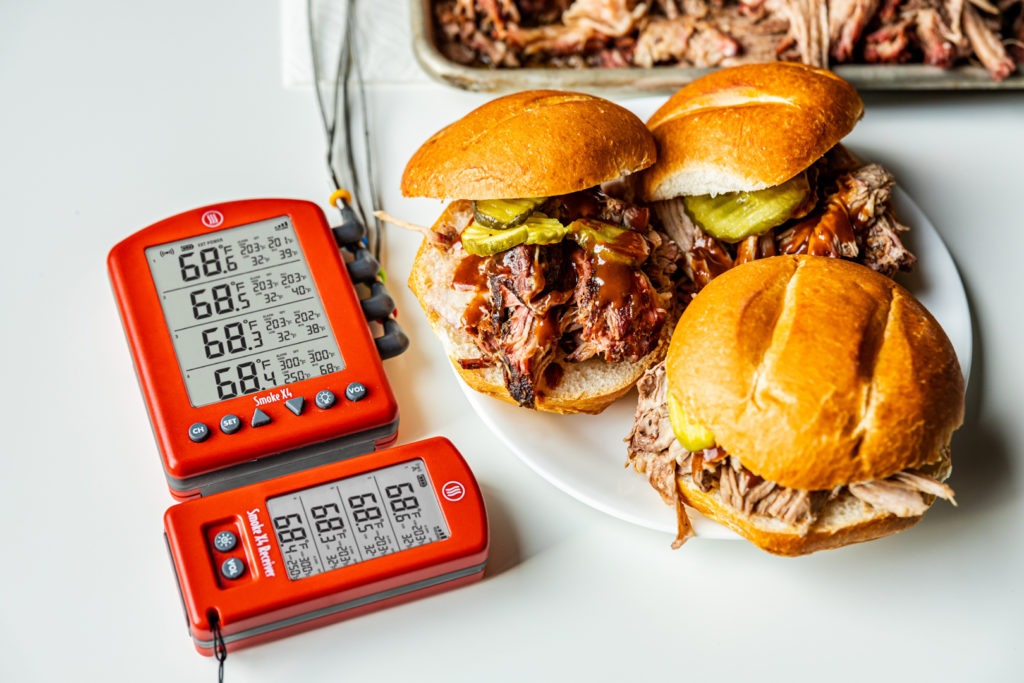
The Smoke line of thermometers is for people that want some freedom of movement and love ease of setup, but don’t need the graphing and data recording capabilities afforded by some of our other thermometers. If you’re cooking away from home where there’s no Wi-Fi, this is a great way to watch your temps—or, if you just prefer not to have to deal connections or apps on your phone or tablet. Because they come with pre-paired purpose-built receiver, Smoke alarms are ready to go right out of the box.
Wi-Fi Thermometers
Signals™, ThermaQ® Wi-Fi, Smoke Gateway Wi-Fi bridge
Our Wi-Fi thermometers offer a wide range of features and specifications. But to communicate wirelessly, they all require Wi-Fi. Each of them communicates with your Wi-Fi router and sends the information to the cloud, whence you can retrieve it with your smart device. With all of them, you can use the ThermoWorks apps on your smart device to record, graph. and export the data from your cook, as well as view it remotely. You can watch the cook happen on your phone while you’re at work and even set an alarm for critical temps—get notified when it’s time to wrap, for instance.
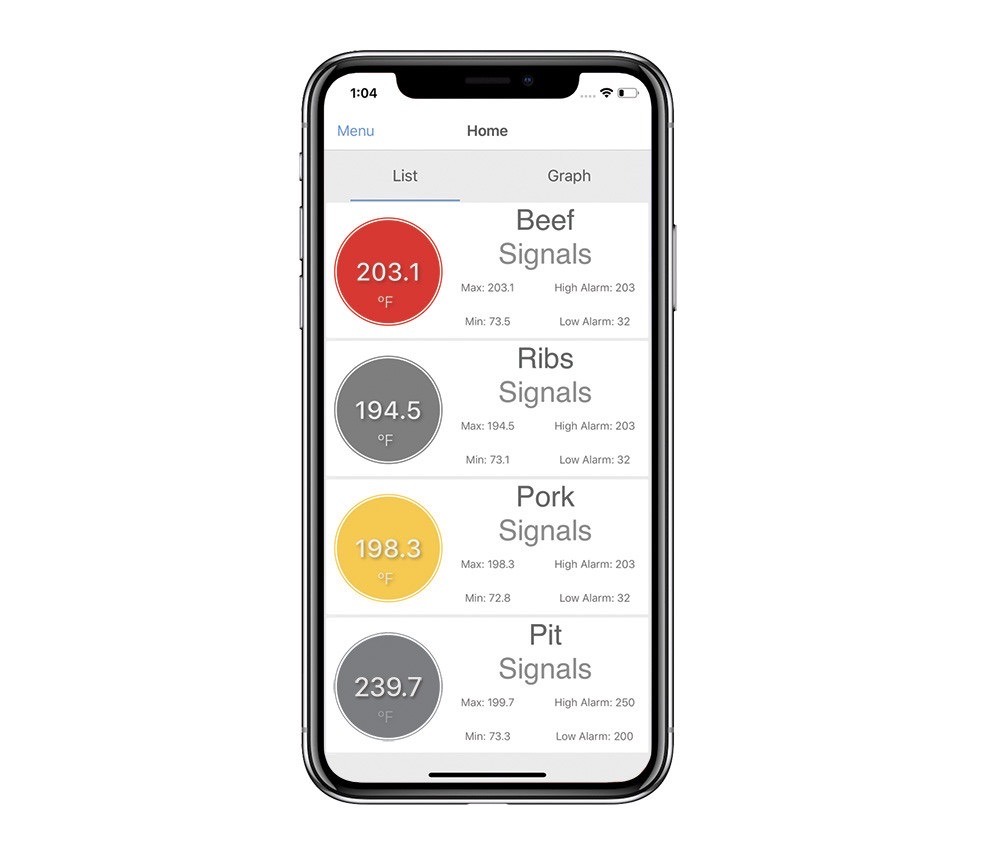
The Wi-Fi setup is more complicated than setting up a Smoke (which is ready out of the box), but if you don’t mind a little work with the app and your Wi-Fi, you can get the job done easily enough, and enjoy the greater freedom to roam and expanded feature set that an internet app affords you.
The ThermaQ Wi-Fi uses two Type-K thermocouple probes, offering unparalleled accuracy for your cook, as well as an astonishing 4,000 hr battery life. It is excellent for the cook that cares about exactness and wants to get their hands on the data, maybe using the data spreadsheet to plan ways to improve the next cook.
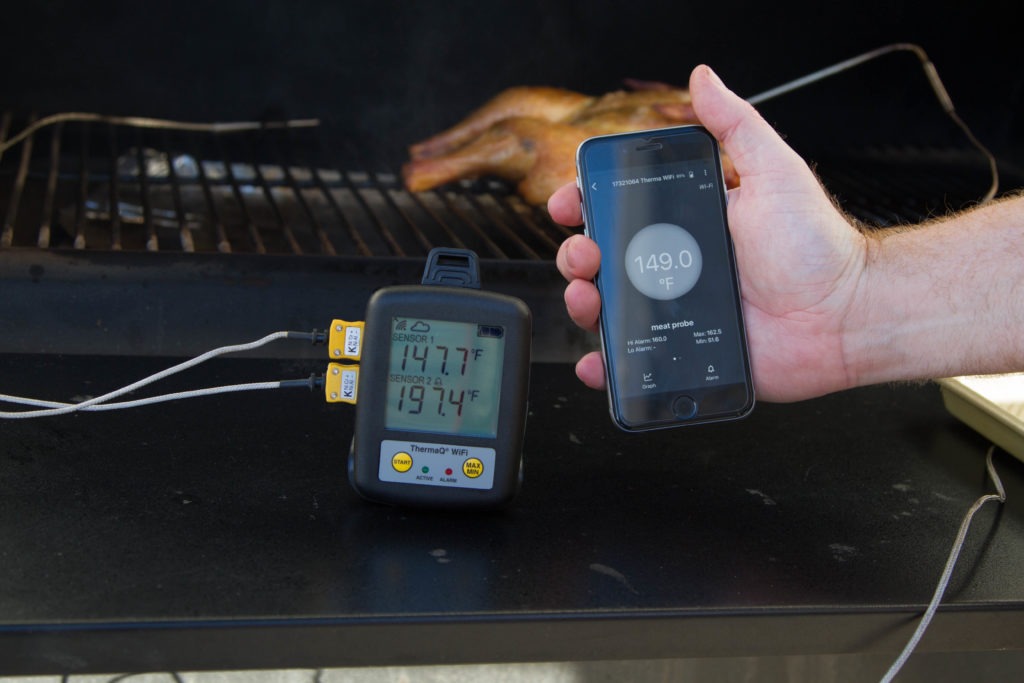
The Gateway Wi-Fi bridge for Smoke brings cloud functionality to the Smoke thermometer. It communicates with the Smoke via standard RF, but communicates with the cloud via Wi-Fi. Set it up and leave it where it can talk to both the base unit and your router and you suddenly get Smoke data anywhere you get a cell signal.
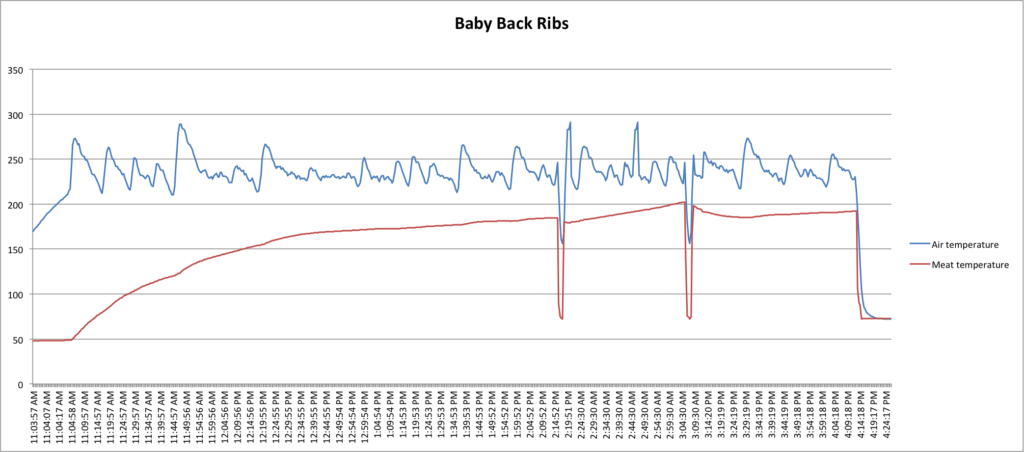
Gateway is great for someone that already has a Smoke but wants to get have access to temps while far from the cooker or who wants the data-gathering and graphing capabilities of our other Wi-Fi thermometers. It’s also great if you want the flexibility of using your receiver or using your smartphone. You can watch the cook on the receiver if you like, but also record the data in the cloud.
It should be noted that Gateway cannot communicate with Smoke X (different frequencies and protocols). And we do not plan on releasing a Wi-Fi bridge for Smoke X. That would turn the Smoke X into a 4-channel, Wi-Fi enabled thermometer with fan control, and we already have one of those: Signals.
Signals offers four channels of monitoring, optional Billows fan control, and Wi-Fi connection to the cloud for use with your cell phone or tablet. The four channels let you track more meats on the smoker with one centralized unit monitoring them all. With the optional Billows fan you can watch 3 meats and control your pit temp all with Signals at the same time.
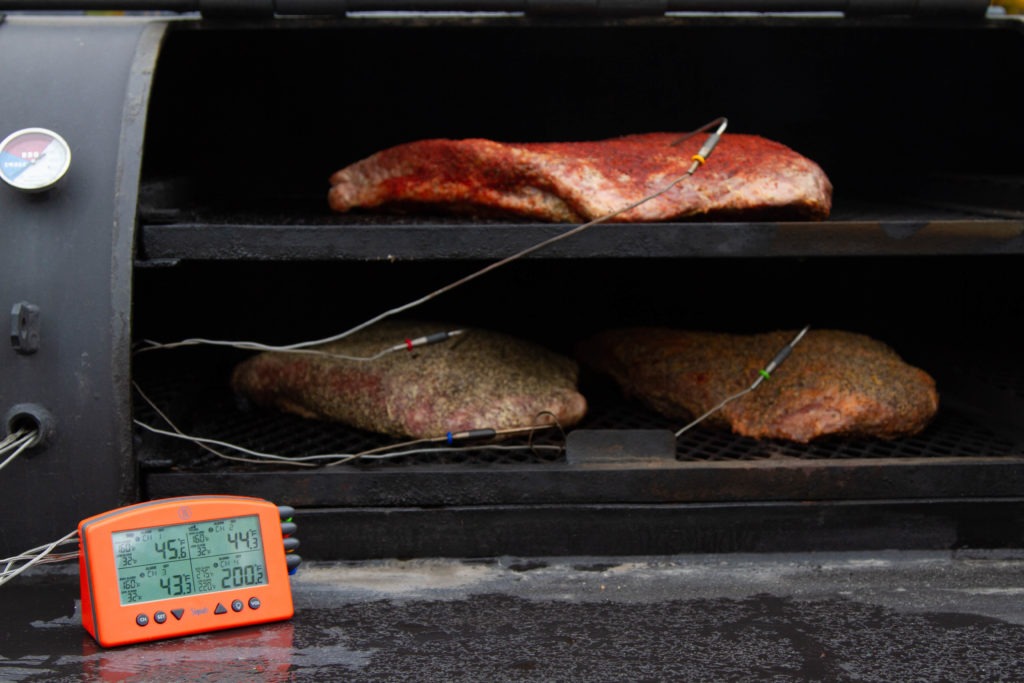
Signals is unique among our thermometers, as well, for its setup option. It uses Bluetooth to ease the process of setting up and connecting to Wi-Fi. It can also use Bluetooth exclusively. Signals offers maximum connectivity with fan control. It’s great for serious Q fiends that compete or cook a lot of meat at home. It’s also great for industry.
Bluetooth Wireless Technology thermometers
BlueDOT®, ThermaQ® Blue, Signals
Bluetooth is, in its unamplified form, a relatively low-power transmission technology. If you have a Bluetooth speaker that you use, you may have found that it cuts out easily if anything comes between it and your phone/computer. Sometimes my speaker cuts out if I have my phone in my pocket and I turn so that the signal has to go through both of my leg bones. That being said, it is very easy to set up. It communicates with your phone or other app-happy device directly, not sending the info to the cloud before landing it in the graphs.
Bluetooth thermometers allow you to record data and be somewhat connected in places where Wi-Fi cannot reach: competitions, camping, or in that corner of your yard that your router can’t quite get to.
I use these thermometers for data recording without long-distance monitoring. I’ll leave my tablet or phone near where it can pick up the Bluetooth signal and let it collect the data and sound alarms. Bluetooth thermometers are great for people that want data gathering and graphing capabilities with easy of setup but don’t feel the need to get that data when far from the smoker. (Except the Signals, of course, which has Wi-Fi, too.)
I’ll skip going over Signals here, since we covered it above. Note, though, that Signals will communicate with either Bluetooth or Wi-Fi at any given moment, but not both. If your Bluetooth is turned on and you walk into Bluetooth range of your Signals, it will stop transmitting via Wi-Fi.
ThermaQ Blue is the Bluetooth answer to the ThermaQ Wi-Fi. It uses two Type K thermocouples for maximum accuracy while communicating via easy-to-set-up Bluetooth. It’s easy to set up, has high accuracy and more probe variations than you can shake a steak at. It also has a higher data transmission frequency rate than ThermaQ Wi-Fi.
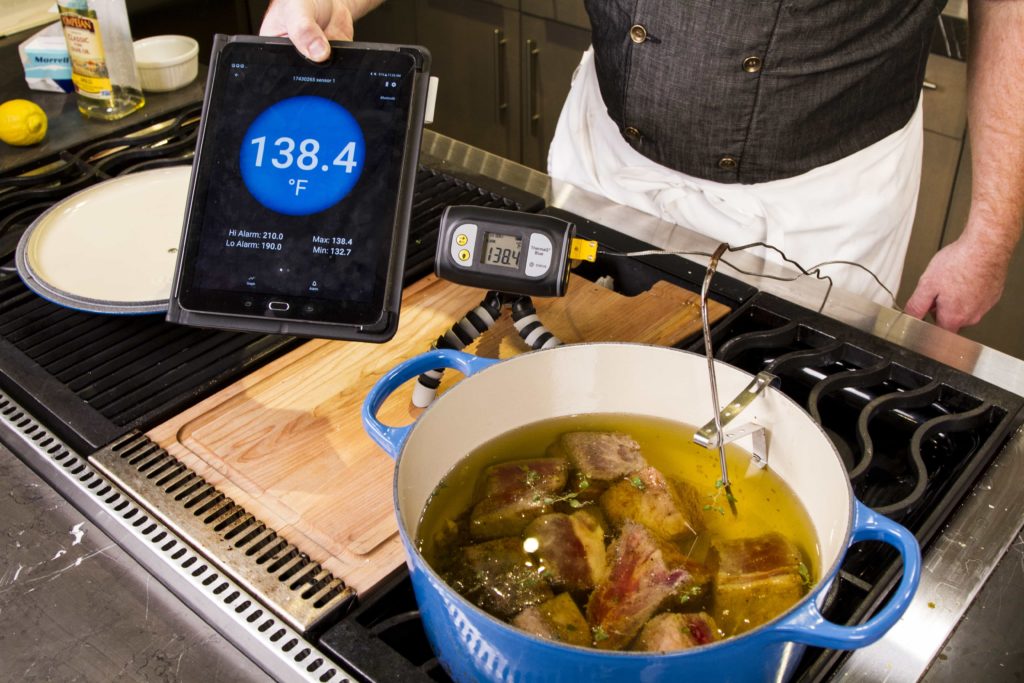
BlueDOT takes our classic DOT® simplicity and design and gives it a data-connected boost. BlueDOT has one channel and two buttons and loads of uses. You can set high and low alarms (the regular DOT only has a high alarm) and you can vary the transmission rate—how often it broadcasts to your device—all the way down to only 2 seconds. It’s great for data gathering with the maximum of simplicity. DOT has long been a BBQ competition staple, and BlueDOT fits right into that niche but with added functionality like graphing.
BlueDOT is also great inside the kitchen for tracking oven temps and making sure roasts and baking turn out just right.
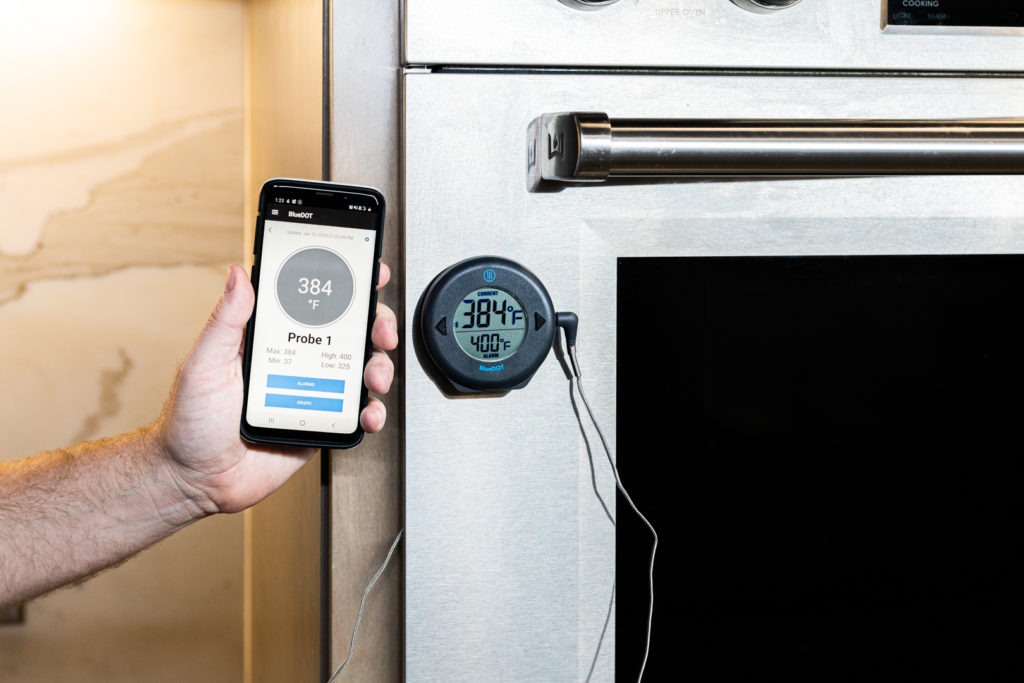
Other options
Of course, if you don’t need a thermometer with wireless transmission, we have you covered there, too. Our alarm thermometers without wireless capability are also top of the line.
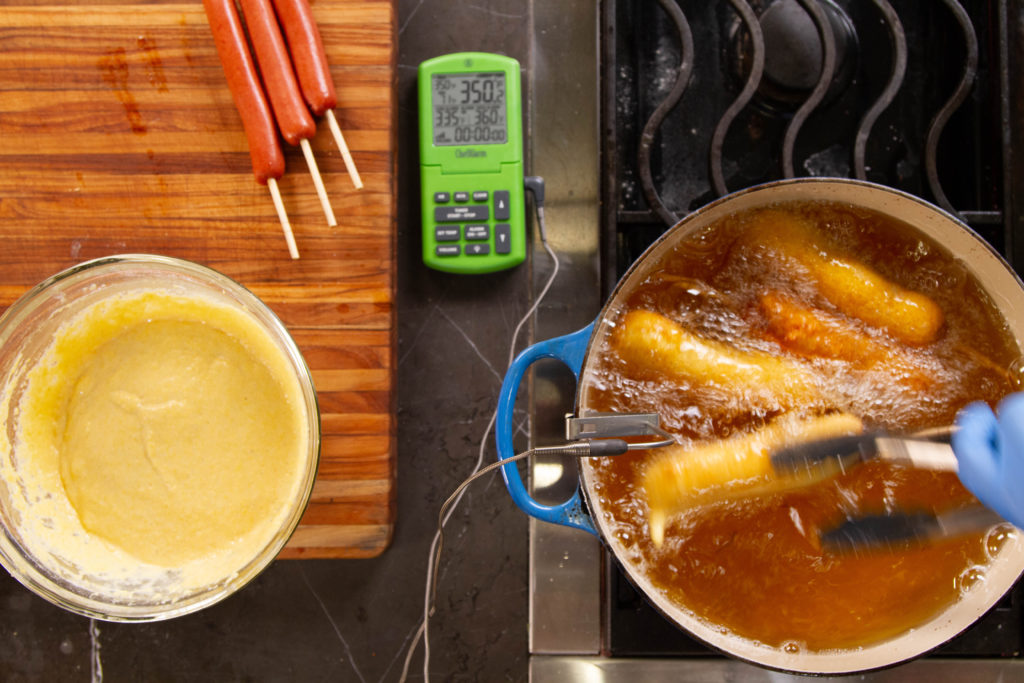
You can choose between our super-simple and affordable two-button DOT thermometer; our ChefAlarm with high and low alarms, a min-max function, and a built-in timer; and our high-accuracy ThermaQ® that has two channels of Type-K thermocouple probes.
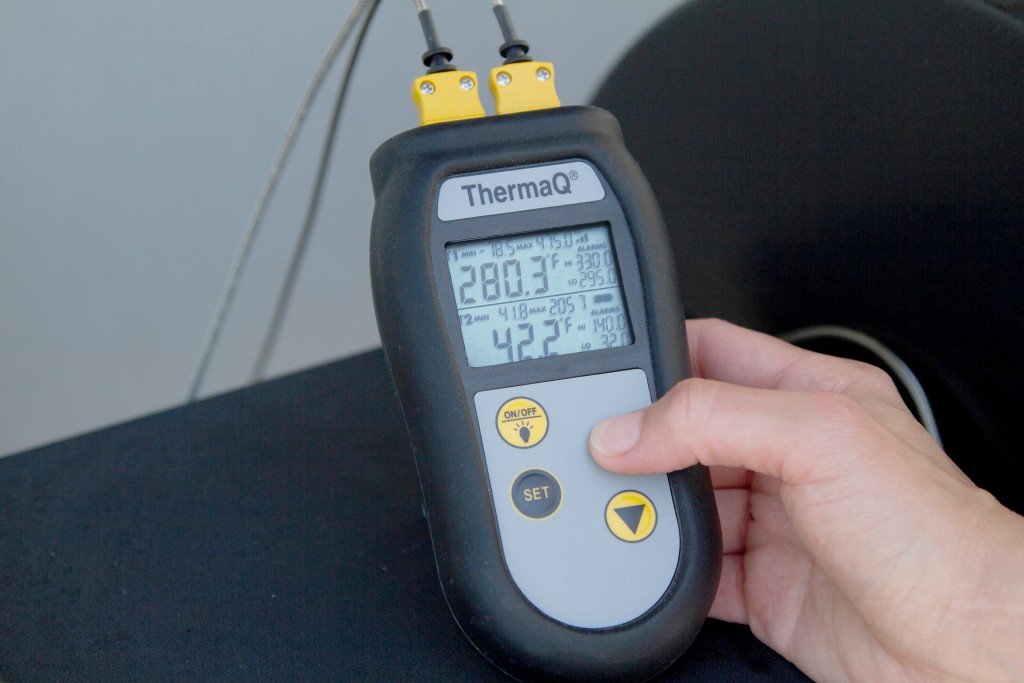
Conclusion
At ThermoWorks, we’ve assembled a whole family of alarm thermometers to meet every kind of need. From the hobbyist to the pro, from the yard to the mountains, from the bbq patio to the kitchen, we have options that get the job done no matter where you are. Temperature matters. Make sure you can control it for the best results when you cook.


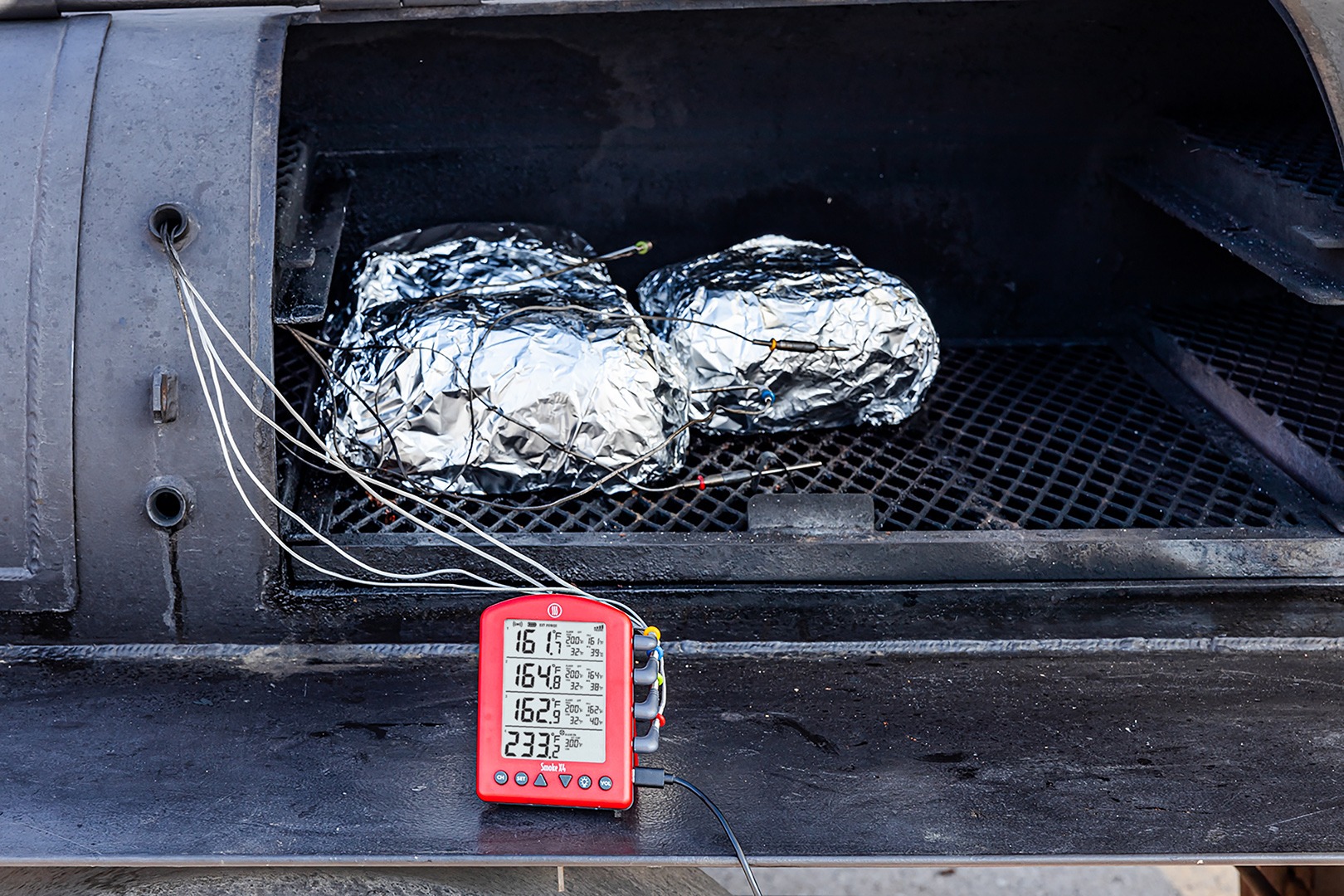
What are you referring to? i.e. ‘ maybe using the data spreadsheet to plan ways to improve the next cook.’ How do I access/use said sheet?
You can download data from the ThermoWorks cloud as a .csv if you’ve been using a cloud-enabled thermometer.
I have a rotisserie BBQ cooker/smoker that has swing trays inside to hold the meat. I need a probe I can stick into the meat that has no wires running to an outside the cooker base unit. With a rotisserie unit any wire will get all tangled and wound-up. Do you have a temperature probe that is wireless but can still transmit temperature readings to an external receiver?
Thanking you in advance,
Delbert
Delbert, I’m afraid we don’t at this time. There are many technical challenges to that problem that we are working to overcome, but know that we’re thinking about it all the time!
As it stands, the best thing is to stop the rotisserie every so often and take the temperature of your meat with an instant-read thermometer.
Do you have available the DOT or BlueDot but with the short blunt probe? We need to monitor the temperature of sterile bags of solution in mobile large animal practice. We cant use the sharp or penetration probes for obvious reasons.
Thank you.
We don’t sell that as one kit, but you can buy any of the Pro-Series® probes to use with the DOT. The air probe of which you speak will certainly work with the DOT. You may want to call our technical sales department, though. They have lots of solutions for strangely specific problems. Call 800-393-6434 and ask for technical sales. We may have an even better solution to your problem!
What do I use to track a roast on a BBQ spit.
Ken,
A spit is a real conundrum. Unfortunately, the best thing for a spit-cook is to stop it every so often and test the temp with a Thermapen or other instant-read thermometer. The cables prevent a direct temp measurement unless you were to mount the thermometer itself to the spit, also, which would certainly void your warranty and probably melt your thermometer!
Hi!
I would like an oven thermometer that will give me an accurate temperature on the rack. I have a collection of the usual round dial ones and get differing results on each in the same oven, essentially the same placement and same time.
Advice, please?
Thanks—I appreciate your Thermopen and IR thermometer gun and use them frequently.
Sharon,
The best choice for an oven thermometer is the ChefAlarm. For accurate oven readings, you need to be able to see the temperature swings created by your oven’s thermostat—it clicks on to heat the oven, then clicks off, allowing the heat to drop to a certain point and then turning on again. The ChefAlarm’s Min/max function makes that easy. You can clip an air probe to your oven rack and easily watch your oven’s temperature. I just used mine for the same purpose the other day because I thought my oven may be on the outs. It turned out to be running even better than I thought.
Oh, and for a little more on testing your oven’s accuracy, see this post.
This was a very enlightening article.
Are any of your thermometers appropriate for use in an air fryer device? For measuring temperature of chicken, beef, or fish? Do you have a recommendation?
The new 2.5″ needle probe is great for air fryers. It’s small enough to fit in the basket with the food and can fit into smaller foods, too.